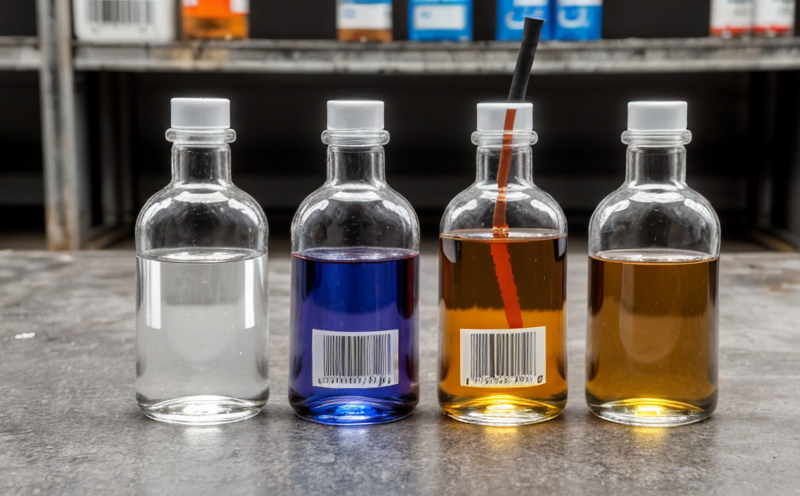ISO 28706 Enamel Coating Chemical Stability Testing
The ISO 28706 standard is specifically designed to assess the chemical stability and degradation of enamel coatings under various environmental conditions. This testing service ensures that enamel coatings used in industrial, automotive, and architectural applications meet stringent quality and durability requirements.
Enamel coatings are widely utilized across sectors due to their excellent resistance properties against corrosion, abrasion, and mechanical stress. However, the chemical stability of these coatings can be affected by environmental factors such as exposure to ultraviolet (UV) light, humidity, temperature variations, and chemicals. ISO 28706 provides a standardized method for evaluating how enamel coatings maintain their integrity under these conditions.
The testing process typically involves exposing coated specimens to specific environments that simulate real-world usage scenarios. These environments are carefully controlled to mimic the most challenging exposure conditions that enamel coatings might encounter during their service life. By subjecting the samples to these conditions, we can accurately measure changes in properties such as color, gloss, and adhesion over time.
The test procedure is designed to be comprehensive, covering both short-term and long-term evaluations of coating performance. Short-term tests help identify immediate changes that could indicate potential issues with the coating’s stability, while long-term testing provides insights into the durability and longevity of the enamel coatings.
For accurate results, it's crucial to follow the ISO 28706 guidelines meticulously. Specimens are prepared according to specified dimensions and finish, ensuring consistency across all samples tested. The specimens are then exposed to controlled environments that replicate the expected usage conditions. Monitoring parameters include color change, gloss retention, adhesion strength, and any visible signs of degradation.
The results from ISO 28706 testing provide valuable information for quality managers, R&D engineers, compliance officers, and procurement teams responsible for ensuring product integrity and meeting regulatory requirements. By adhering to this standard, manufacturers can confirm that their enamel coatings will perform reliably in the field, reducing the risk of premature failure and associated costs.
Table 1 below summarizes some key parameters measured during ISO 28706 testing:
| Parameter | Description |
|---|---|
| Color Change | The change in color of the enamel coating after exposure to specified conditions. |
| Gloss Retention | The degree to which the gloss of the coated surface is maintained over time. |
| Adhesion Strength | The force required to peel or remove the coating from the substrate. |
| Surface Roughness | The texture change on the surface after exposure. |
Understanding these parameters is essential for predicting the long-term performance of enamel coatings in various applications. The testing process not only ensures product quality but also supports continuous improvement efforts by providing actionable data for R&D teams.
In summary, ISO 28706 enamel coating chemical stability testing offers a robust framework for evaluating the durability and reliability of enamel coatings used in critical industries. By following this standard, manufacturers can ensure that their products meet stringent quality standards and perform well under real-world conditions.
Industry Applications
- Aerospace: Ensuring durability of protective coatings in space environments.
- Automotive: Evaluating the resistance of enamel coatings to UV exposure and chemicals.
- Construction: Assessing the long-term performance of architectural coatings used on buildings.
- Electrical Engineering: Testing the stability of enamel coatings used in electrical components.
The ISO 28706 standard is particularly valuable for industries where enamel coatings play a critical role in protecting materials from environmental degradation. The testing process helps manufacturers and material scientists to understand how different coating formulations perform under various conditions, enabling them to make informed decisions about product development and quality assurance.
Table 1 provides a summary of the key parameters measured during ISO 28706 testing, which are crucial for evaluating the chemical stability and degradation resistance of enamel coatings. These parameters include color change, gloss retention, adhesion strength, and surface roughness. Understanding these metrics is essential for predicting the long-term performance of enamel coatings in diverse applications.
The results from ISO 28706 testing provide valuable insights into how enamel coatings will behave under real-world conditions. This information is invaluable for quality managers, R&D engineers, compliance officers, and procurement teams who are responsible for ensuring product integrity and meeting regulatory requirements.
Why Choose This Test?
The ISO 28706 standard is a cornerstone in the evaluation of enamel coating chemical stability, offering a standardized approach that ensures consistent and reliable results. By choosing this test, you can:
- Avoid costly failures due to premature degradation.
- Ensure compliance with international standards and regulations.
- Promote continuous improvement through accurate data collection.
- Gain a competitive edge by offering high-quality products.
The testing process is rigorous, incorporating controlled environments that simulate real-world conditions. This ensures that the results are relevant and applicable to actual field performance. Compliance with ISO 28706 demonstrates your commitment to quality and reliability, which can enhance your reputation in the market.
Moreover, by adhering to this standard, you can ensure that your enamel coatings will perform reliably under a wide range of conditions. This not only reduces the risk of premature failure but also minimizes maintenance costs and downtime, leading to increased customer satisfaction and loyalty.
Customer Impact and Satisfaction
The ISO 28706 standard significantly impacts both the quality of products offered to customers and overall customer satisfaction. Here’s how:
- Better Product Quality: By adhering to this standard, manufacturers can ensure that their enamel coatings meet rigorous quality standards.
- Increased Customer Trust: Compliance with international standards builds trust among customers who value reliability and durability.
- Enhanced Reputation: Demonstrating commitment to quality through standardized testing enhances the reputation of the manufacturer in the industry.
- Competitive Advantage: Offering products that meet or exceed ISO 28706 standards can provide a competitive edge over competitors who do not adhere to such stringent protocols.
The long-term benefits of adhering to this standard extend beyond immediate product quality. It fosters continuous improvement, ensures regulatory compliance, and contributes to overall customer satisfaction by delivering products that meet or exceed expectations in terms of performance and reliability.





